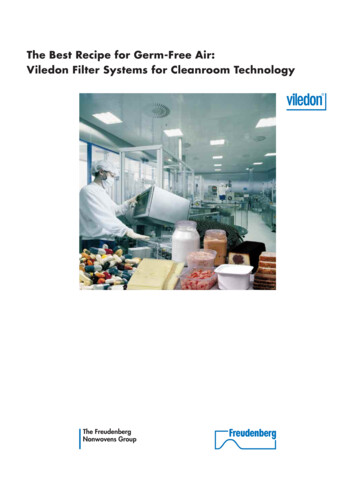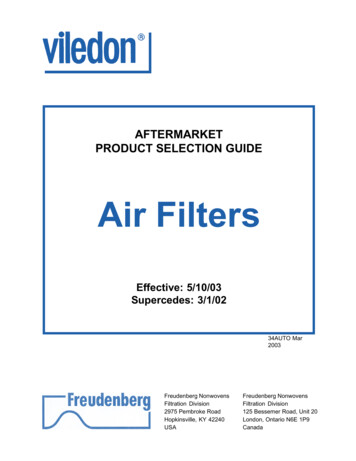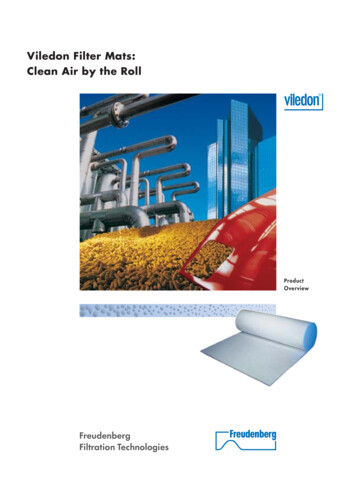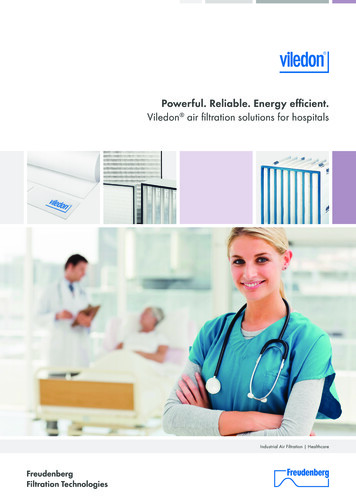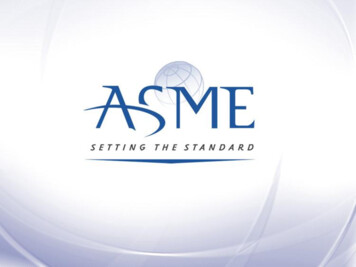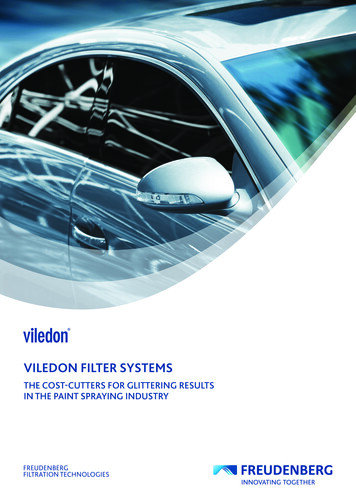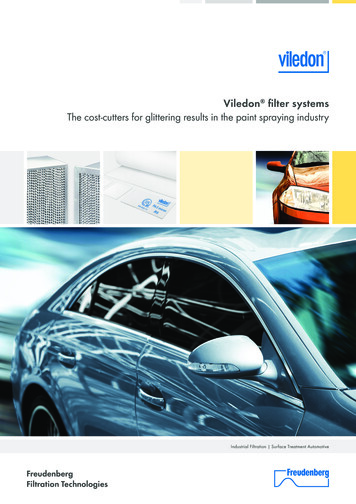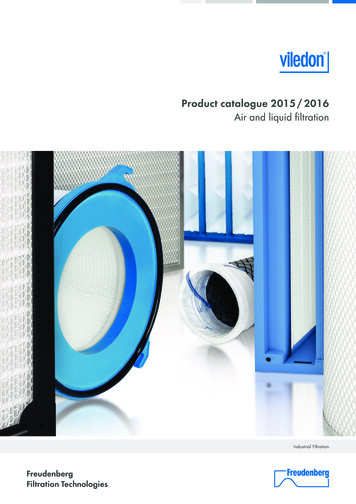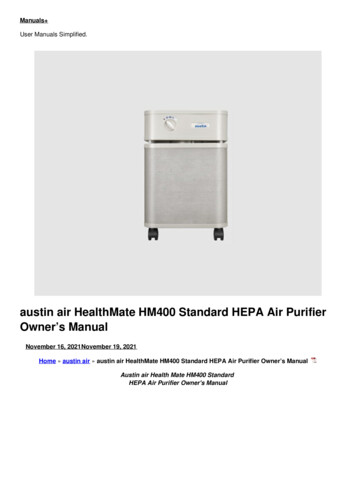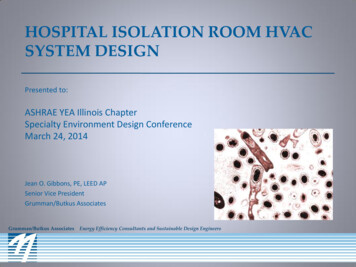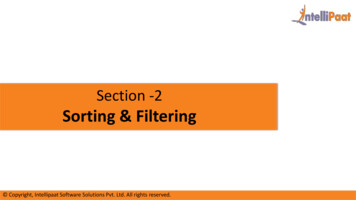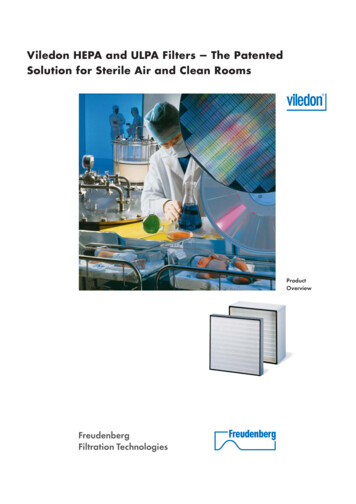
Transcription
Viledon HEPA and ULPA Filters – The PatentedSolution for Sterile Air and Clean RoomsProductOverview
In a class of their own for technology andperformanceWhile the performance qualities of air filters inClasses F 5 to F 9 are assessed in terms of theefficiency for the particle size 0.4 µm, averagedover the dust loading, to EN 779, HEPA andULPA filters from Class H10 upwards are classified in terms of their particle-size-referenced minimum efficiency in new condition as laid down byEN 1822. This classification by minimum collection efficiencies is based on minimum curves describing the arrestance characteristics of HEPAand ULPA filter media with defined particle sizesat nominal media velocity.The particle size at which the medium exhibits thelowest collection efficiency is called the MostPenetrating Particle Size (MPPS). The typical parabolic shape of these minimum curves shows thatparticles both larger and smaller than the MPPSare arrested more effectively (see graph on theright).The European standard EN1822 replaces variousnational standards like DIN 24183, DIN 24184,BS 3928 and AFNOR 44013: when EN 1822was drawn up, it was based on DIN 24183,and is largely identical to it.EN 1822 distinguishes between HEPA filters(High-Efficiency Particulate Air Filters) up to ClassH14, and ULPA filters (Ultra Low Penetration AirFilters), from Class U 15 upwards. The table below shows previous classification systems forHEPA and ULPA filters in comparison with EN1822 and the US Military Standard.Integralefficiency*for MPPSEN1822Filter Class toDINDINBS24183 24184 3928US Mil. Std.292 85 % 95 % 99.5 % 99.95 % 99.995 % 99.9995 % 99.99995 % 99.999995 %H 10H 11H 12H 13H 14U 15U 16U 17EU 10EU 11EU 12EU 13EU 14EU 15EU 16EU 17– 95 % 99.97 % 99.99 % 99.999 %–––QR–S––––EU 10EU 11EU 12EU 13EU 14–––* The integral efficiency is the mean value of all local efficiencies measured over the filter’s facearea.Fractional efficiency T(x) [%]InertiaDiffusionEfficiencyminimum(x MPPS)0.010.020.05 0.1MPPS0.2 0.3 0.5123Particle diameter [ m]MPPS: Most Penetrating Particle SizeEfficiency minimumMinimum curve for an H13 filter mediumElaborate in every detail .Viledon HEPA and ULPA filters are manufacturedusing our patented thermal embossing processor the minipleating technique. In the minipleating technique, thin hotmelt threads serve for fixing and spacing the pleats. It is used for pleatdepths of up to 100 mm.In the thermal embossing process, a complementary pair of cylinders simultaneously embosses conical dimples and the subsequent pleattips into a heated micro-glassfiber paper containing a thermoplastic bonder. The bonder thenhardens again, fixing the embossed structures inthe paper (see illustration below).Thermal embossing process
The embossed dimples mean that after pleatingthe filter medium spaces itself, so that no additional spacer materials need be used (see illustration on the right).At the same time, the embossing process givesthe filter medium an additional inherent rigidity, enabling pleat depths of up to 280 mm tobe achieved. The unusually high stability of thepleat packs (which can be as much as 1220 mmwide) is reinforced by applying a fine adhesiveonto the backs of the dimples and by plasticthreads running over the pleat tips. This patented thermal embossing technique creates equidistant pleats, whose precise V-shape geometry ensures optimum air flow through the pleatpack.The equidistance of the pleats also results inlow-turbulence downstream air flow, a crucialfactor in laminar flow applications.Cross-section through a 280 mm deep pleat pack (embossingtechnique)V-shaped pleats, back-litPleat spacingFaltenabstandPleat depthltentiefeThermal embossing process: pleating without any spacer materials. and tried and trusted in practiceViledon HEPA and ULPA filters constitute an innovative milestone in terms of cost-efficiency andoperational reliability – a truly up-to-the-futureperformance:Exceptionally reliable and cost-efficient operation, providing very low pressure drops evenat high volume flowsHomogeneous flow characteristics, resultingfrom the optimized pleat geometryLow-turbulence downstream air flow, thanksto equidistant, geometrically precise pleatsLightweight filter elements for easy handlingSecure and leak-free installation with a continuous, homogeneously foamed-on PU gasketAdditional security against leaks, since nosharp-edged metal separators are usedFull incinerability for the filter elements inthe plastic-framed version.Pleat pack in minipleating techniqueConical dimplesglued togetherKonische Ausprägungengegeneinander verklebt
A product range that thinks of everythingProtection grids on both sides offer additionalsecurity against mechanical damage to the filtermedium during handling. Plastic-framed filterelements can be supplied with plastic protectiongrids. Metal-framed models can on request befitted with protection grids made of powdercoated metal mesh or aluminium mesh. Filtersfrom Class H14 and/or with a pleat depth of280 mm are fitted with protection grids on bothsides as a standard feature.Handles fitted on request to the side of theframe make it easier to replace and dispose offilters contaminated with hazardous dusts.The tight fit of the filter elements in the mounting system is achieved by continuous, homogeneously foamed-on PU semicircular profilegaskets. The filters with plastic or sheet-metalframes can on request also be supplied with flatgaskets.For the fluid sealing systems frequently used incleanroom applications, filter frames both withfluid gel and with a knife-edge can be supplied.Viledon HEPA/ULPA filters are available up toClass U17. The filter elements up to Class H13are manufactured with plastic frames in thestandard version. The patented frame designcombines crucial product advantages: Plasticframed HEPA filters are not only very stable,microbiologically safe, non-corroding, moistureresistant and light-weight, but also fully incinerable. They meet all hygiene requirements for airfilters used in HVAC systems to EN 13779 andthe German VDI Guideline 6022, offering maximized security against the growth of bacteriaand moulds. The suitability for cleanrooms up toCleanliness Class 2 according to ISO 14644-1(Class 0.1 to US Fed. Std. 209) has been certified by the German Fraunhofer Institute for Manufacturing Engineering and Automation, IPA.When the requirements for laminar flow are extremely stringent, the filter elements can additionally be fitted with a laminarizing medium onthe clean-air side.Filter elements intended for single-flow configurations feature a cast-in hood for airtight sealing and are available with different connectionspigots. In addition, we also offer terminal housings, duct housings and fan filter units.From Class H14, either plastic or anodized extruded aluminium is the standard frame variant.For specialized applications we also offer framematerials like galvanized or stainless steel sheeting, as well as a filter version for high volumeflows with an especially large filter surface area.Fan filter unit
Testing times for quality productsReg. No. 1420FreudenbergFiltration TechnologiesWeinheim/GermanyAt Freudenberg, quality is an across-the-boardcommitment, which starts off with full comprehension of the customer’s requirements, before translating these into products, processes and services. A modern Quality Management System toISO 9001 monitors all operations, from the verybeginning of development work and applicationengineering consultancy all the way through todelivery of the finished product.flow rate, the pressure drop, the collection efficiency for MPPS and any leaks as well.To ascertain the local collection efficiencies, thefilter element is tested with an aerosol whoseparticle size has been set to the MPPS valuepreviously determined. The particle number concentration on the raw-air side is measured continuously during the filter scan by means of acondensation nucleus counter (CNC).On the clean-air side, a pair of sensors, connected to two CNCs, scans the entire surface ofthe filter, and measures the local particle concentrations. If one of these local concentrationsexceeds a predefined limit value, this point isdetected as a leak.In conclusion, the local penetration values, theoverall collection efficiency calculated from this,and the pressure drop, together with all relevant test parameters, are recorded in graphicalform in a test certificate, provided with each filter element. These individual test reports are animportant constituent of the qualification andvalidation documents for submission to the regulatory authorities.Scan test rig for individual testing of filters from Class H13Consistently high quality of the filter media usedis essential if the completed filter elements areto perform properly. For quality assurance ofthe HEPA/ULPA filters, the filter media involvedare tested for pressure drop and collection efficiency, determining the specific minimum curvewith the MPPS (Most Penetrating Particle Size /efficiency minimum) of the medium under test.The MPPS concerned will later serve as the testparticle size for scan-testing the finished filterelements during final inspection.Following the scan test, there is an option fordetermining a velocity profile of the downstreamair flow at freely selectable positions, using hotwire anemometry, and recording it in a separatetest report.srticler of paNumbe3500280021001400700387ignal 1Leak s0FilFor individual testing of all HEPA/ULPA filtersfrom Class H13 in conformity with EN 1822,Freudenberg uses one of the world’s most sophisticated scanning test rigs, besides the approved oil-thread test. The fully automated filterscanning system determines, at nominal volumeterlengtEfficiency:Upstream particleconcentration:Leak signal:hFilterwidth99.995 % for MPPS370,000 particles/cm31,387 particlesScan test graph for an H14 filter
Maximum air volume in minimum space:Viledon HEPA filters, Classes H10 to H13Pressure drop (Pa)for 610 x 610 mm2 filter elements / Classes H 11 and H 1330012250200150100500500100015002000250030003500 4000Volume flow (m3/h)1 H 13 / Frame depth 68/78 mm / Pleat depth 50 mm2 H 13 / Frame depth 150 mm / Pleat depth 100 mm3 H 13 / Frame depth 292 mm / Pleat depth 200 mm4 H 13 / Frame depth 292 mm / Pleat depth 280 mm5 H 11 / Frame depth 292 mm / Pleat depth 200 mm6 H 11 / Frame depth 292 mm / Pleat depth 280 mmNominal volumeflowViledon HEPA filters in Classes H10 to H13 areused for supply, exhaust and recirculated-airfiltration in ventilation systems with very stringentrequirements for clean-air quality and sterility,e.g.in operating theatres and intensive-care unitsat hospitalsin cleanroomsin highly sensitive industrial processes likeelectronics, pharmaceuticals, chemicals, cosmetics, optics, foodstuffs, precision engineeringin handling hazardous substances like carcinogenic dusts, asbestos disposal, heavy metalsin the nuclear industry and its research facilitiesViledon HEPA filters can handle very large volumes of air at a specified pressure drop, orachieve very low pressure drops for a specifiedvolume flow. So you can either get big performance in a small space, or cut your energy costs,whichever you like.
Laminar flow with minimum pressure drop:Viledon HEPA and ULPA filters, Classes H14 to U17Pressure drop (Pa) for Class H 14150110025000.05 0.1 0.15 0.2 0.25 0.3 0.35 0.4 0.45 0.5 0.55 0.6Face velocity (m/s)1 H 14: Frame depth 68 mm or 78 mm / Pleat depth 50 mm2 H 14: Frame depth 88 mm / Pleat depth 70 mmPressure drop (Pa) for Class H 1415012345100500500100015002000Volume flow (m3/h)1 305 x 610 mm / Frame depth 68/78 mm 2 305 x 610 mm / Frame depth 88 mm3 610 x 610 mm / Frame depth 68/78 mm 4 610 x 610 mm / Frame depth 88 mm5 610 x 1220 mm / Frame depth 68/78 mm 6 610 x 1220 mm / Frame depth 88 mmPleat depth 50 mmPleat depth 70 mmViledon HEPA and ULPA filters in Classes H14 toU17 are used for supply, exhaust and recirculatedair filtration in ventilation systems with extremelystringent requirements for clean-air quality andsterility, e.g.in laminar flow boxesin laminar-flow areas in pharmaceutical processes, operating theatres, etc.in micro-electronics (e.g. semiconductor manufacturing)in ceiling outlets and modules for flexiblecleanroom systems (filter-fan modules).The particularly large quantities of air which haveto be recirculated continuously in laminar-flowapplications entail correspondingly high energycosts. So every Pascal of pressure drop at thefilters installed shows up only too clearly in thesystem operating costs. Viledon cleanroom filters, with low pressure drops by virtue of theirflow-optimized pleat geometry, offer economicaloperation here.In turbulent mixed ventilation, our high-capacityfilter elements with their especially large filtersurface area enable substantial cost savings tobe achieved.
Filter ClassH 11H 13H 14U 15U 16U 17Overallframe depthPleat depthFacevelocityNominal volume flow for610 x 610 mm2 elementPressuredrop78 mm50 mm0.97 m/s1,300 m3/h160 Pa150 mm100 mm1.49 m/s2,000 m /h160 Pa292 mm200 mm2.37 m/s3,000 m /h160 Pa292 mm280 mm2.54 m/s3,400 m3/h160 Pa68/78 mm50 mm0.90 m/s1,200 m /h240 Pa150 mm100 mm1.12 m/s1,500 m3/h220 Pa292 mm200 mm1.87 m/s2,500 m /h250 Pa292 mm280 mm2.54 m/s3,400 m3/h250 Pa3333292 mm12x25 mm2.99 m/s4,000 m /h250 Pa68/78/80 mm50 mm0.45 m/s600 m3/h120 Pa88 mm70 mm0.45 m/s600 m /h90 Pa102 mm70 mm0.45 m/s600 m /h90 Pa292 mm280 mm1.27 m/s1,700 m3/h150 Pa292 mm12x25 mm2.99 m/s4,000 m3/h320 Pa68/80 mm50 mm0.45 m/s600 m3/h145 Pa33388 mm70 mm0.45 m/s600 m /h115 Pa102 mm70 mm0.45 m/s600 m3/h115 Pa68/80 mm50 mm0.45 m/s600 m /h160 Pa88 mm70 mm0.45 m/s600 m3/h130 Pa33102 mm70 mm0.45 m/s600 m /h130 Pa68/80 mm50 mm0.45 m/s600 m3/h180 Pa88 mm70 mm0.45 m/s600 m /h150 Pa102 mm70 mm0.45 m/s600 m /h150 Pa333Numerous other versions, including filter/hood modules and fan filter units, plus accessories (terminal housings,duct housings, mounting frames etc.) are available on request.In the case of filters with a laminarizing medium on the clean-air side, the pressure drop will increase by approx. 10 Pa,with a hood by approx. 20 Pa at a face velocity of 0.45 m/s.The figures given are mean values subject to tolerances due to the normal production fluctuations.Our explicit written confirmation is always required for the correctness and applicability of the information involved in any particular case. Subject to technical alterations.Freudenberg Filtration Technologies KG69465 Weinheim /GermanyTel. 49 (0) 6201/80-6264 Fax 49 (0) 6201/88-6299viledon@freudenberg-filter.com www.viledon-filter.comYou will find instructions on how to handle anddispose of loaded filters in our information onproduct safety and eco-compatibility.LRO 060 April 2008 · Replaces all previous issues of this brochure · Printed on paper bleached without chlorine.Viledon HEPA and ULPA filters –Top of the class every time
Viledon HEPA filters, Classes H10 to H13 Viledon HEPA filters in Classes H10 to H13 are used for supply, exhaust and recirculated-air filtration in ventilation systems with very stringent requirements for clean-air quality and sterility, e.g. in operating theatres and intensive-care units at hospitals in cleanrooms
